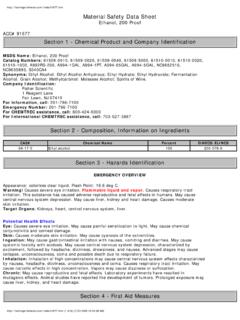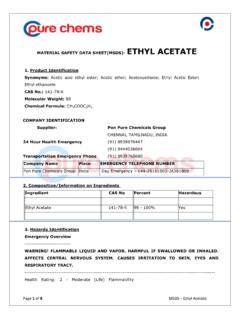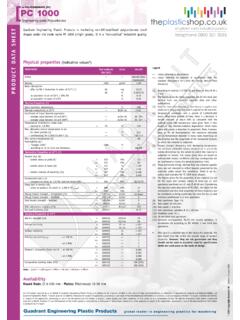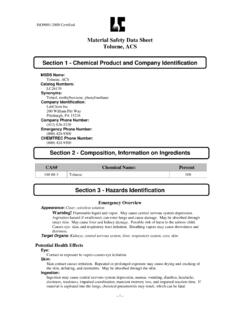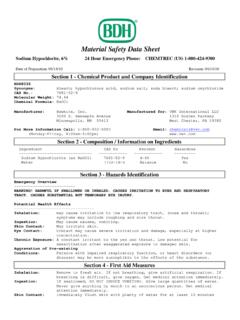Transcription of MATERIAL SAFETY DATA SHEET
1 Page 1 of 7 MATERIAL SAFETY data SHEET 1. CHEMICAL PRODUCT & COMPANY IDENTIFICATION PRODUCT: Bitumen SAN 0469 MANUFACTURER: Syncrude Canada Ltd. Bag 4009 Fort McMurray, AB Canada T9H 3L1 Emergency Telephone No. (780) 790-5094 SYNONYMS: Coker Feed, LC-Finer Feed, Vacuum Distillation Unit Feed, Plant 7 Bitumen Product Syncrude Sample Tag # s: 071019, 072019, 221001, 371001 PRODUCT USE: Process stream extracted bitumen, coker feed.
2 PREPARED BY: Nathalie B rub (780) 790-4544 DATE OF PREPARATION/REVISION: March 7, 2006 2. COMPOSITION, INFORMATION ON INGREDIENTS CAS #: 8052-42-4 Topped heavy oil extracted from oilsand. Black or brownish, tar like texture. A complex combination of high molecular weight organic compounds with carbon numbers greater than C16, with high carbon-to hydrogen ratios. It also contains small amounts of various metals such as nickel, iron, and vanadium. 3.
3 HAZARDS IDENTIFICATION EMERGENCY OVERVIEW: A black or dark brown highly viscous liquid. Heated bitumen can cause severe skin burns and eye injury. Eye, skin, gastrointestinal, and respiratory tract irritation can occur. Poisonous hydrogen sulfide gas may accumulate in confined spaces. ROUTE OF ENTRY: Skin contact, Eye contact, Inhalation, Ingestion EFFECTS OF ACUTE EXPOSURE: EYES: Hot bitumen and bitumen fumes may cause severe irritation and burns. Cold bitumen may cause slight irritation. Bitumen dust may cause irritation characterized by burning, redness, swelling and watering.
4 SAN 0469 Bitumen MATERIAL SAFETY data SHEET Syncrude Canada Ltd. Page 2 of 7 SKIN: Hot bitumen and bitumen fumes may cause moderate to severe irritation and burns. Cold bitumen may cause moderate irritation. Bitumen dust may cause irritation characterized by redness and occasional drying and peeling. INGESTION: Irritation of gastrointestinal tract, vomiting and a danger of aspiration. Aspiration can develop into potentially fatal chemical pneumonitis. INHALATION: Bitumen fumes may cause moderate to severe irritation of the nose, throat and respiratory tract.
5 May cause headache, nausea, sore throat, nasal congestion, dizziness and nervousness. Confined spaces may accumulate hydrogen sulfide gas. Hydrogen sulfide may cause respiratory tract irritation, nausea, headache, dizziness, pulmonary edema, loss of consciousness, brain damage and death. EFFECTS OF CHRONIC EXPOSURE: EYES: Effects not reported. SKIN: Repeated exposure to hot bitumen or bitumen fumes may cause inflammation of the skin, acne like lesions, development of horny growths on the skin, darkening of the skin and sensitization of the skin to light.
6 Bitumen may cause hair loss, dryness, scaling, and dermatitis. May aggravate existing skin conditions. Bitumen contains chemicals that may have a carcinogenic potential. INGESTION: Effects not reported. INHALATION: Prolonged exposure to bitumen fumes may cause inflammation of the lungs and mucous membranes of the nose and throat. May cause chronic bronchitis, pulmonary congestion, laryngitis, hoarseness, coughing, fatigue and atrophy and/or death of the epithelium. May aggravate existing respiratory conditions. 4. FIRST AID MEASURES EYES: Immediately flush eyes with water for at least 15 minutes.
7 If irritation persists, seek medical attention. SKIN: Remove contaminated clothing. Use a light mineral oil ( baby oil) to help remove bitumen from the skin. Wash affected area with soap and water. Avoid abrading the skin during washing. If irritation persists, seek medical attention. INGESTION: DO NOT INDUCE VOMITING BECAUSE OF DANGER OF ASPIRATING LIQUID INTO LUNGS. If spontaneous vomiting occurs, monitor for breathing difficulty. Get immediate medical attention. INHALATION: Move victim to uncontaminated area. If breathing has stopped, trained personnel should begin artificial respiration, or, if the heart has stopped, cardiopulmonary resuscitation (CPR) immediately.
8 Oxygen may be beneficial if administered by a person trained in its use, preferably on a physician's advice. GENERAL: In all cases, seek medical attention. 5. FIRE FIGHTING MEASURES MATERIAL SAFETY data SHEET Bitumen SAN 0469 Syncrude Canada Ltd. Page 3 of 7 FLASH POINT: 166 C (Cleveland Open Cup) FLAMMABLE LIMITS (% by volume): Upper - Lower - AUTO-IGNITION TEMPERATURE: Not available. FIRE & EXPLOSION HAZARDS: Flammable in presence of ignition source when heated above flashpoint temperature. EXTINGUISHING MEDIA: Foam, Carbon, Dioxide, dry chemical, water fog.
9 Caution: Hot bitumen will react violently with water. FIRE FIGHTING PROCEDURES: DO NOT USE WATER on a bitumen tank fire; it may cause violent eruption and spreading of burning bitumen. Hot MATERIAL may ignite flammable mixtures (liquids) on contact. MATERIAL will not burn unless preheated. Exposed firefighters must wear full bunker gear, including a NIOSH approved positive pressure self-contained breathing apparatus with full-face mask. Containers exposed to intense heat from fires should be cooled with water to prevent vapour pressure build-up, which could result in container rupture.
10 Container areas exposed to direct flame contact should be cooled with large quantities of water as needed to prevent weakening of container structure. 6. ACCIDENTAL RELEASE MEASURES LEAK AND SPILL PROCEDURE: Shut off fuel source and ventilate spill area. Dike large spills with non-flammable MATERIAL . Absorb on inert MATERIAL and place in closed container for recycling or disposal. 7. HANDLING AND STORAGE HANDLING PROCEDURES AND EQUIPMENT: Avoid excessive heating and oxidizing materials. Wash hands thoroughly after handling. STORAGE REQUIREMENTS: Keep away from heat and flame.

